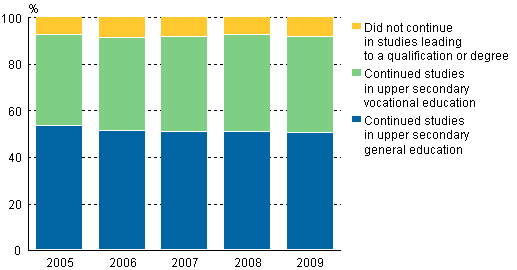Published: 9 December 2010
Immediate continuation of studies was more difficult in 2009 than in the year before for both completers of the 9th grade of comprehensive school and passers of the matriculation examination
According to Statistics Finland, immediate continuation of studies was more difficult in 2009 than in the year before for both completers of the 9th grade of comprehensive school and passers of the matriculation examination. Over eight per cent of completers of the comprehensive school and 60 per cent of new passers of the matriculation examination failed to get a place for further studies. The share of those left outside further studies leading to a qualification or degree grew by one percentage point from the previous year.
Direct transition to further studies of completers of the 9th grade of comprehensive school 2005-2009, %

Completers of the 9th grade of comprehensive school numbered some 64,000, or six hundred fewer than one year earlier. Half of them (58 per cent of women and 42 per cent of men) went on to study in upper secondary general school. Forty-one per cent (33 per cent of women and 49 per cent of men) went on to attend upper secondary level vocational education. A total of 8.6 per cent did not continue any studies leading to a qualification or degree. Their share grew by one percentage point from the previous year. Nearly all applied for further studies as barely two per cent did not do so.
The share of completers of the comprehensive school who continued to upper secondary general education was higher than the average for the whole country in the regions of Uusimaa, Pirkanmaa and Varsinais-Suomi. The number who continued to vocational education was highest in the region of Central Ostrobothnia and lowest in Uusimaa. The number of young people who did not continue to any studies leading to a qualification or degree after the comprehensive school was highest in the region of Päijät-Häme.
New passers of the matriculation examination numbered 33,000, or about as many as in the year before. Of the newly matriculated students, 18 per cent entered university education and 18 per cent polytechnic education in autumn of the same year. The proportion of those who continued to university or polytechnic education decreased by just under two percentage points from the previous year. Four per cent entered upper secondary vocational education. More than one-half, or 60 per cent, of the passers of the matriculation examination in 2009 did not continue studying in their year of graduation. The proportion of those left outside further studies has exceeded one-half in recent years, and now grew again by further 1.5 percentage points from the previous. Seventy-five per cent of the new passers of the matriculation examination applied for further studies. The share of applicants was a couple of percentage points greater than in the previous year.
Entry to university education was easiest for students from the regions of Ostrobothnia and North Karelia. The largest numbers of students in Central and South Ostrobothnia continued to polytechnic education. Students having passers of the matriculation examination in Uusimaa and Päijät-Häme remained most frequently outside further studies.
Source: Education 2010. Statistics Finland
Inquiries: Ritva Kaukonen (09) 1734 3311, koulutustilastot@stat.fi
Director in charge: Jari Tarkoma
Publication in pdf-format (227.2 kB)
- Tables
-
Tables in databases
Pick the data you need into tables, view the data as graphs, or download the data for your use.
Appendix tables
Updated 9.12.2010
Official Statistics of Finland (OSF):
Entrance to education [e-publication].
ISSN=1799-4527. 2009. Helsinki: Statistics Finland [referred: 28.12.2025].
Access method: http://stat.fi/til/khak/2009/khak_2009_2010-12-09_tie_001_en.html

